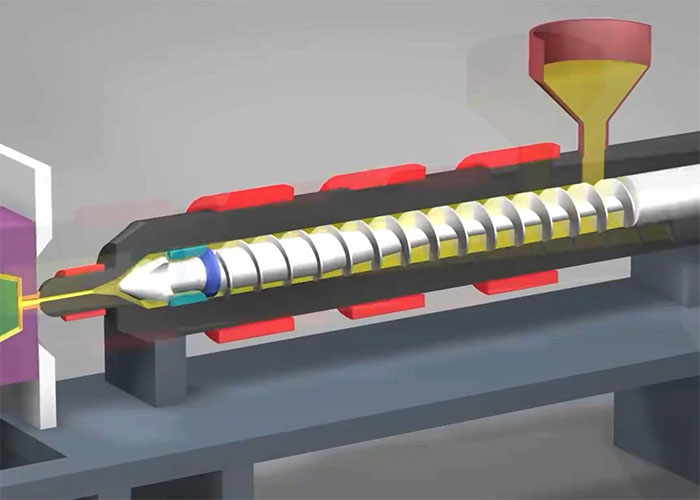How back pressure affects injection molding?
The back pressure during pre-molding indicates the pressure in the metering chamber of the screw during pre-molding.
Back pressure has a greater influence on melt temperature
The increase of backpressure makes the material in the screw groove compact and prolongs the thermal process of the material in the screw. The quality of plasticization has also been improved. Excessive back pressure will make the shear heat too high, which may degrade the material.
Back pressure is needed in the following situations
Uniform heating and melting, especially those particles that have not yet melted due to sheer heat. Mechanical and appearance uniformity, uniform dispersion of masterbatch (toner) and filler (glass fiber). The air brought in by the removed material is discharged toward the inlet.
Produce a uniform melting temperature gradient axis, especially when the effective screw metering length is shortened. Reduce the residual buffer melt during the pressure holding period due to the air trapping and causing fluctuations between each mold.
Backpressure is one of the important parameters to control melt quality and product quality in the injection molding process. Proper back pressure plays an important role in improving product quality and directly affects the quality of melt filling and plastic parts.
(1) Proper back pressure can improve the quality of products
①It can compact the melt in the barrel, increase the density, and improve the injection volume, product weight, and dimensional stability;
② The gas in the melt can be squeezed out to reduce air blooms and internal bubbles on the surface of the product, and improve the uniformity of gloss;
③ Slow down the screw retreat speed so that the melt in the barrel is fully plasticized, the mixing uniformity of the toner, color masterbatch, and melt is increased, and the product color mixing phenomenon is avoided;
④ Properly increasing the back pressure can improve the shrinkage of the product surface and the glue running around the product;
⑤ It can increase the humidity of the melt, improve the plasticization quality of the melt, and improve the fluidity of the melt when filling the mold. There is no cold glue pattern on the surface of the product.
(2) The impact of excessive back pressure on products
① The melt pressure at the front end of the barrel is too high, the material temperature is high, and the viscosity decreases. The reverse flow of the melt in the screw groove and the increase in the leakage flow between the barrel and the screw will reduce the plasticization efficiency;
② For plastics with poor thermal stability (such as PVC, POM, etc.) or colorants, the temperature of the molten material increases, and the heating time in the barrel increases, resulting in thermal decomposition, or the degree of color change increases, and the surface color and luster of the product Get worse;
③ The back pressure is too high, the screw retreats slowly, and the pre-plastic return time is long, which will increase the cycle time and reduce the production efficiency;
④ The back pressure is high and the melt pressure is high. After the glue is injected, the nozzle is prone to melt drooling. When the glue is injected next time, the cold material in the nozzle runner will block the nozzle or cold material spots will appear in the product;
⑤ During the injection molding process, the nozzle leaks due to excessive back pressure, which wastes raw materials and causes the heating ring near the nozzle to burn out;
⑥ The mechanical wear of the pre-plastic mechanism and the screw barrel is increased. To
(3) The impact of low back pressure on products
① When the back pressure is too low, the screw retreats too fast, the density of the melt flowing into the front end of the fan barrel is small (relatively loose), and more air is trapped;
② It will lead to poor plasticization quality, unstable injection volume, and large changes in product weight and product size;
③ The surface of the product will appear shrinkage, air blooms, cold material lines, uneven gloss, and other undesirable phenomena;
④ Bubbles are easy to appear inside the product, and the periphery and bones of the product are easy to move and dissatisfied with the glue.
(4) Guidance method for back pressure setting
The back pressure of injection molding should be adjusted according to the properties of the raw materials, drying conditions, product structure, and quality conditions. The backpressure is generally adjusted at 3-15kg/cm3. When the product surface has a little air bloom, color mixing, shrinkage, and large changes in product size and weight, the back pressure can be appropriately increased. When the nozzle leaks, salivates, melts overheated and decomposes, discolors the product, and returns too slowly, you can consider reducing the backpressure appropriately.
You may also be interested in the below articles.
Summary Of 50 Injection Mold Structure Operation Dynamic Diagrams
Auto Parts Stamping Die Design Concept




